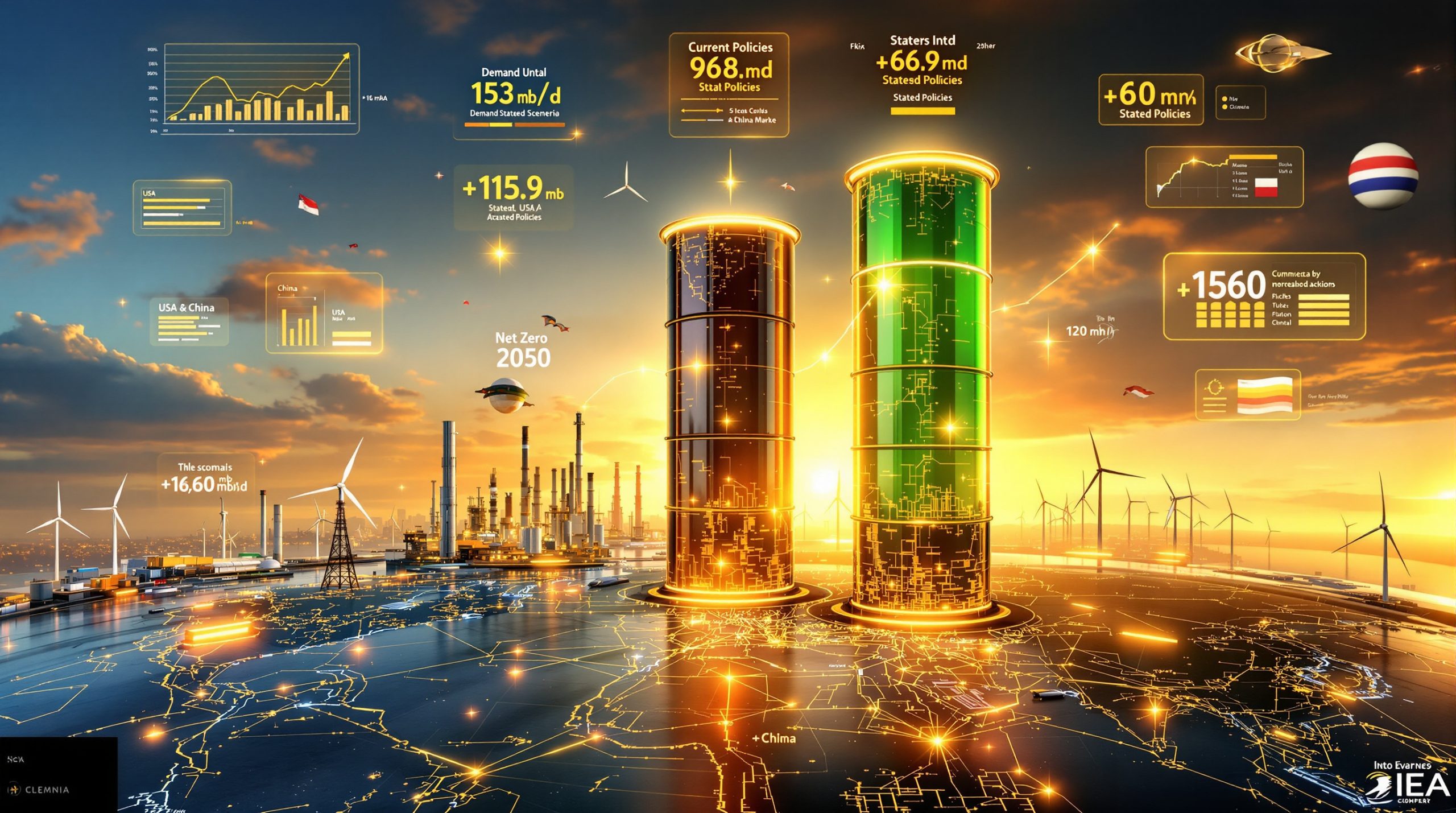Understanding the EU-U.S. Energy Trade Deal
In a landmark agreement that has sent shockwaves through global energy markets, the European Union has committed to purchasing $750 billion worth of American energy products over the next three years. This ambitious target represents more than a tripling of current import levels, which currently stand at approximately $76 billion annually according to Eurostat data. To meet the target, EU countries would need to collectively import around $250 billion of U.S. energy each year—an unprecedented increase in bilateral energy trade.
European Commission President Ursula von der Leyen emphasized the strategic importance of this agreement, stating: "Purchases of U.S. energy products will diversify our sources of supply and contribute to Europe's energy security. We will replace Russian gas and oil with significant purchases of U.S. LNG, oil, and nuclear fuels."
While the political will behind this agreement is strong, energy analysts have raised questions about the feasibility of implementation within the three-year window. The deal coincides with a broader trade framework that reduced initially proposed 30% tariffs' economic implications on EU goods down to 15%, highlighting the economic and diplomatic significance of this energy partnership.
Key Challenge: The EU must find ways to triple its energy imports from the U.S. in just three years, despite significant infrastructure and production limitations.
Why Is the EU Seeking More American Energy?
The EU's aggressive pursuit of American energy stems from its strategic objective to eliminate Russian energy dependence by 2027. Following Russia's 2022 actions in Ukraine, European nations have fundamentally reevaluated their energy security framework, recognizing the geopolitical vulnerabilities associated with reliance on Russian supplies.
American energy partnership offers the EU several critical advantages:
- Supply security: Diversification away from politically volatile sources
- Geopolitical alignment: Strengthening transatlantic economic bonds
- Market stability: Accessing energy from a stable democratic partner
- Long-term planning: Creating predictable supply relationships
Since 2022, the EU has dramatically transformed its energy landscape, accelerating renewable deployment while simultaneously seeking reliable fossil fuel alternatives during the transition period. American LNG has already played a crucial role in this shift, with import terminals across Europe increasing their capacity to receive shipments.
The challenge now lies in scaling these imports to unprecedented levels within a compressed timeframe, requiring not only political will but substantial infrastructure investment and market restructuring.
What Are the Current U.S. Energy Export Capabilities?
The United States has undergone a remarkable transformation from energy importer to export powerhouse. According to the Energy Information Administration (EIA), total U.S. energy exports to all countries reached approximately $318 billion in recent years, with 2024 marking record-breaking export levels across petroleum products, crude oil, and natural gas.
This energy renaissance has positioned America as a global energy supplier, but questions remain about whether even this robust export machine can meet Europe's ambitious targets.
Current U.S. export capabilities include:
| Energy Type | Export Status | Expansion Potential |
|---|---|---|
| LNG | Record high, capacity constrained | Significant projects underway |
| Crude Oil | Strong growth trajectory | Limited by production economics |
| Petroleum Products | Established export channels | Moderate expansion possible |
| Nuclear Fuel | Specialized niche market | Potential for targeted growth |
The critical limitation facing U.S. exporters isn't production capacity but rather export infrastructure. Particularly for natural gas, the process of liquefaction and marine terminal loading creates bottlenecks that cannot be quickly overcome, regardless of how much gas is produced domestically.
Industry Insight: While the U.S. produces abundant natural gas, the specialized infrastructure required to liquefy and export it takes years to develop, even with expedited permitting.
Can U.S. LNG Production Meet European Demand?
Current Export Capacity
The United States has undergone a remarkable transformation in LNG exports, growing from just 0.5 Bcf/d (billion cubic feet per day) in 2016 to a substantial 11.9 Bcf/d in 2024. This dramatic expansion has propelled America to become the world's largest LNG exporter, surpassing Qatar and Australia in 2023.
Current U.S. LNG export terminals are operating at near-maximum capacity, with utilization rates consistently above 95% throughout 2023-2024. This leaves minimal headroom for increased exports without bringing new facilities online.
Planned Expansion Projects
Several major LNG export projects are currently under construction that will significantly expand U.S. capacity:
- Plaquemines LNG (Louisiana): Construction progress at 37%, with first shipments expected in 2025
- Corpus Christi LNG Stage 3 (Texas): Advancing toward completion with targeted operational date in 2025
- Golden Pass LNG (Texas): Joint venture between QatarEnergy and ExxonMobil, scheduled for 2025 completion
Together, these projects will add a combined nominal export capacity of 5.3 Bcf/d, with potential peak capacity reaching 6.3 Bcf/d—representing almost a 50% increase in U.S. LNG export capabilities once fully operational.
However, even this substantial expansion falls significantly short of what would be required to meet Europe's ambitious import targets. According to the EIA's Annual Energy Outlook 2025, all US nuclear fuel production growth through 2028 will result from facilities already under construction, with long-term projections suggesting maximum new capacity additions of 0.8 trillion cubic feet annually between 2030-2050.
What Are the Market Realities Challenging the Deal?
The EU-U.S. energy trade deal faces significant market challenges beyond mere production and infrastructure constraints. U.S. LNG exporters operate with flexible pricing and destination-free contracts, allowing them to direct shipments to the highest-paying markets globally.
This market reality creates significant complications for European buyers:
- Asian premium: Japanese, South Korean, and Chinese buyers routinely outbid European counterparts during high-demand periods
- Contract flexibility: Most U.S. LNG is not contractually obligated to specific destinations
- Global competition: Japan and India have aggressively moved to secure U.S. LNG supplies through long-term agreements
- Market-based allocation: U.S. energy follows price signals rather than political directives
An often overlooked challenge is that U.S. exporters are private companies with fiduciary responsibilities to shareholders—not government entities that can be directed to prioritize specific export markets. While policy can influence market conditions, it cannot fundamentally override commercial decision-making without significant regulatory changes.
Market Reality: During winter demand spikes, Asian buyers have historically paid premiums of $5-15/MMBtu above European prices, naturally diverting U.S. LNG cargoes away from European terminals.
How Would Tripling EU Energy Imports Impact Markets?
The planned increase from $76 billion to $250 billion in annual energy imports would create substantial ripple effects throughout global energy markets. This magnitude of demand shift would likely trigger price volatility across multiple energy commodities.
Potential market impacts include:
Price Effects
- Upward pressure on global LNG spot prices
- Widening price differentials between U.S. and international natural gas
- Potential oil price dynamics as export volumes increase
- Premium pricing for certain petroleum products favored by European buyers
Infrastructure Requirements
- Accelerated development of European LNG import terminals
- Expanded pipeline networks for gas distribution within Europe
- Storage facility investments to manage seasonal demand patterns
- Specialized handling facilities for nuclear fuel components
The scale of this trade expansion would require coordinated investment on both sides of the Atlantic. European buyers would need to commit to long-term contracts to justify U.S. infrastructure expansion, while American producers would need confidence in sustained European demand to finance new export facilities.
Industry analysts estimate that achieving the targeted import levels would require at least €50-75 billion in European infrastructure investment alone, not including the corresponding American export facilities.
What's the Timeline for New Export Capacity?
The development timeline for new energy export infrastructure represents one of the most significant challenges to the EU-U.S. agreement. According to the EIA, all U.S. LNG export growth through 2028 will come exclusively from facilities already under construction as of June 2024.
Realistic capacity addition schedule:
| Timeline | Expected Capacity Additions | Status |
|---|---|---|
| 2025 | Initial phases of Plaquemines and Golden Pass | Under construction |
| 2026 | Full operation of Corpus Christi Stage 3 | Under construction |
| 2027 | Complete operation of all current projects | Under construction |
| 2028-2030 | Potential new projects not yet approved | Regulatory uncertainty |
The regulatory approval process for new LNG export facilities in the U.S. has become increasingly complex, with environmental reviews, public comment periods, and legal challenges extending timelines. From initial application to first cargo shipment, new greenfield LNG projects typically require 5-7 years under optimal conditions.
This regulatory reality creates a fundamental mismatch between the three-year timeframe of the EU-U.S. agreement and the physical constraints of energy infrastructure development.
How Might This Affect U.S. Domestic Energy Prices?
The massive increase in U.S. energy exports to Europe raises legitimate concerns about domestic American energy prices. The economic mechanism is straightforward: international LNG price increases incentivize more U.S. exports, potentially reducing domestic supply and driving up prices for American consumers and industries.
Several factors would influence the domestic price impact:
- Production response: How quickly U.S. producers increase output to meet export demand
- Infrastructure bottlenecks: Pipeline capacity limitations affecting regional price disparities
- Seasonal patterns: Winter heating demand competing with export commitments
- Industrial consumption: Manufacturing sector sensitivity to natural gas price increases
The political dimension cannot be overlooked. The administration faces a delicate balancing act between supporting European allies and protecting American consumers from energy price inflation. This tension has already manifested in debates around LNG export permit approvals, with domestic price concerns cited as justification for more cautious expansion.
Economic Impact: Studies suggest that each additional 1 Bcf/d of LNG exports could increase U.S. natural gas prices by 3-8%, depending on production elasticity and infrastructure constraints.
What Alternative Solutions Could Bridge the Gap?
Given the physical and timeline constraints of LNG expansion, alternative energy products will likely play a crucial role in meeting the overall $750 billion commitment. Several possibilities show significant potential:
Petroleum Exports
- Crude oil: U.S. production continues to set records, with fewer infrastructure constraints than LNG
- Refined products: European refinery closures have increased import needs for diesel and other products
- Implementation advantage: Existing infrastructure allows for faster scaling
Nuclear Fuel Supply
- Enriched uranium: European dependence on Russian nuclear fuel creates opportunity
- Strategic priority: High-value, lower-volume product with significant security implications
- Technical challenge: Specialized handling and regulatory requirements
Energy Technology Exports
- Renewable components: Solar panels, wind turbines, and battery-grade lithium insights
- Efficiency technologies: Advanced HVAC, industrial controls, and smart grid systems
- Development opportunity: Expands the definition of "energy products" beyond commodities
Hydrogen Development
- Emerging sector: Joint development of hydrogen production and transport
- Long-term potential: Could represent significant future trade volume
- Timeline advantage: Develops in parallel with immediate LNG needs
These alternatives could collectively address a substantial portion of the trade target while diversification beyond solely natural gas reduces infrastructure bottlenecks and expands opportunities.
FAQ: EU-U.S. Energy Trade Deal
Will the EU actually purchase $750 billion in U.S. energy?
The $750 billion target represents a political ambition rather than a binding commercial commitment. Achievement will depend on infrastructure development, market conditions, and the ability to diversify beyond LNG into other energy products. Most analysts consider the full target aspirational rather than guaranteed.
How does this deal affect global climate commitments?
The agreement creates tension with climate goals, as it potentially locks in fossil fuel infrastructure for decades. However, European officials argue that U.S. natural gas has a lower carbon intensity than alternatives like coal and that the agreement includes provisions for renewable energy technology trade and hydrogen development.
What happens if the export targets cannot be met?
The agreement lacks specific penalties for underperformance. More likely, both sides would engage in diplomatic discussions to adjust expectations and timelines if physical constraints prevent target achievement. Alternative energy products could be emphasized to compensate for LNG limitations.
How will this impact U.S.-Russia relations?
The explicit goal of replacing Russian energy imports with American alternatives represents a significant geopolitical realignment. Russian diplomatic responses have been predictably negative, characterizing the agreement as economic warfare rather than market competition.
What are the implications for European energy prices?
European consumers will likely face higher energy costs as a result of this transition. U.S. LNG typically commands a premium over pipeline gas due to liquefaction and shipping costs. However, European officials argue that energy security justifies these additional costs, particularly if they can be moderated through efficiency improvements and renewable integration.
Europe's Energy Security Transformation
The ambitious EU-U.S. energy agreement represents a fundamental reshaping of transatlantic energy relations, driven by both security concerns and market evolution. While physical constraints create significant challenges to full implementation within the three-year timeframe, the direction of travel is clear: Europe is committed to diversifying away from Russian energy dependence, with American supplies playing a central role in this transition.
The ultimate success of this initiative will depend on realistic assessments of infrastructure capabilities, market dynamics, and the ability to expand beyond LNG into other energy products. With appropriate expectations and flexible implementation, this agreement could indeed strengthen energy security while creating substantial economic opportunities on both sides of the Atlantic.
The potential impact on the US economy and tariffs cannot be overstated, as this massive export opportunity could offset some of the economic tensions caused by broader trade policy changes. Furthermore, according to Reuters, many energy analysts have described the EU's $250 billion per year spending target as "unrealistic" given current market conditions.
Disclaimer: This analysis reflects current market conditions and announced projects as of publication. Energy markets are inherently volatile, and regulatory, technological, or geopolitical developments could significantly alter the feasibility of meeting the stated trade targets.
Want to Invest in the Next Major Energy Discovery?
Discover potentially transformative ASX energy investment opportunities the moment they're announced with Discovery Alert's proprietary Discovery IQ model, providing instant notifications on significant energy and mineral discoveries across all commodities. Explore historic examples of exceptional returns from major discoveries by visiting Discovery Alert's dedicated discoveries page and begin your 30-day free trial today.




